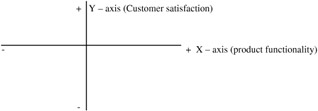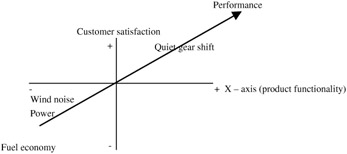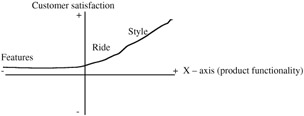KANO MODEL
The tool of choice that is preferred for understanding the "function" is the Kano model. A typical framework of the model is shown in Figure 2.5. The Kano model identifies three aspects of quality, each having a different effect on customer satisfaction. They are:
-
Basic quality ” take for granted they exist
-
Performance quality ” the more principle
-
Excitement quality ” the wow

Figure 2.5: Kano model framework.
The more we find out about these three aspects from the customer, the more successful we are going to be in our DFSS venture. (Caution: It is imperative to understand that the customer talks in everyday language, and that this language may or may not be acceptable from a design perspective. It is the engineer's responsibility to translate the language data into a form that may prove worthwhile in requirements as well as verification. A good source for more detailed information is the 1993 book by Shoji.)
BASIC QUALITY
"Basic" quality refers to items that the customer is dissatisfied with when the product performs poorly but is not more satisfied with when the product performs well. Fixing these items will not raise satisfaction beyond a minimum point. These items may be identified in the Kano model as in Figure 2.6.

Figure 2.6: Basic quality depicted in the Kano model.
Some sources for the basic quality characteristics are: things gone right, things gone wrong, surrogate data, surveys, warranty, and market research.
PERFORMANCE QUALITY
"Performance" quality refers to items that the customer is more satisfied with more of. In other words, the better the product performs the more satisfied the customer. The worse the product performs, the less satisfied the customer. Attributes that can be classified as linear satisfiers fall into this category. A typical depiction is shown in Figure 2.7.

Figure 2.7: Performance quality depicted in the Kano model.
Some sources for performance quality characteristics are: internal satisfaction analysis, customer interviews, corporate targets/goals, competition, and benchmarking.
EXCITEMENT QUALITY
"Excitement" quality refers to items that the customer is more satisfied with when the product is more functional but is not less satisfied with when it is not. This is the area where the customer can be really surprised and delighted . A typical depiction of these attributes is shown in Figure 2.8.

Figure 2.8: Excitement quality depicted in the Kano model.
Some sources for excitement quality characteristics are: customer insight, technology, interviews with comments such as high % or better than expected.
Items that are identified as surprise/delight candidates are very fickle in the sense that they may change without warning. Indeed, they become expectations. The engineer must be very cautious here because items that are identified as excitement items now may not predict excitement at some future date. In fact, we already know that over time the surprised/delighted items become performance items, the performance items become basic, and the basic items become inherent attributes of the product. A classic example is the brakes of an automobile. The traditional brakes were the default item. However, when disc brakes came in as a new technology, they were indeed the excitement item of the hour . They were replaced , however, with the ABS brake system, and now even this is about to be displaced by the electronic brake system. This evolution may be seen in the Kano model in Figure 2.9.

Figure 2.9: Excitement quality depicted over time in the Kano model.
Developing these "surprised and delighted" items requires activities that gain insight into the customers' emotions and motivations. It requires an investment of time to talk with and observe the customer in the customer's own setting, and the use of the potential product. Above all, it requires the ability to read the customer's latent needs and unspoken requirements.
Is there a way to sustain the delight of the customer? We believe that there is. Once the attributes have been identified, a robust design must be initiated with two objectives in mind.
-
Minimize the degradation of these items.
-
Preserve the basic quality beyond expectations.
These two steps will create an outstanding reliability and durability reputation.
EAN: 2147483647
Pages: 235